10k on Substack! What I've Learned & What I'd Do Again
nine lessons from posting my way out of the void
Celebrating 10k with a fun promo—all annual subs are $69 and monthlies are $6.90 (regularly $100/yr and $10/mo). No code needed, offer good through 10/26. Thanks for reading with me, and supporting my work. I appreciate you so much! x
In honor of hitting 10k readers, this post includes:
9 hard-earned takeaways for anyone writing online or growing something of their own.
A full breakdown of the creative pillars I’ve built over the past year.
Behind-the-scenes stories from my most viral and most hated posts.
Links to over a dozen essays, and prompts for deeper exploration.
A peek at what I’m building next (plus a little something personal I rarely share publicly)
If you’re new here, you can explore my full archive chronologically, or browse by theme using the glossary of thoughts.
When I first started writing on Substack, it felt like posting into the void. I’d send essays out into the world and hear nothing back. Zero likes, no comments, no traction. Just a bunch of empty heart icons at the bottom of my screen and the sound of my own thoughts echoing. But I kept writing anyway. I didn’t know which piece would resonate (or if any of them ever would) but I knew the only way to find out was to keep going.
Fast-forward to today, a little more than a year later, and I just crossed 10,000 subscribers (THANK YOU!) And while that number still doesn’t feel real, I know I didn’t arrive here by accident. I’ve posted over 100 pieces, a couple of which have gone viral, most of which haven’t. I’ve written about AI, politics, beauty, taste, intimacy, capitalism, memory, discipline, you name it—not because I thought it would perform well, but because I was genuinely curious. And that genuine curiosity is the only compass I’ve ever trusted when it comes to publishing work on this platform.
There’s a lot I’ve learned along the way—some of it practical, some of it deeply emotional. (I’d be lying if I said I didn’t almost crash out a couple times lol)
I want to share a few of those lessons here (nine, to be exact), not as a blueprint, but as a reflection. My hope is that this piece feels useful to anyone growing something online: a newsletter, a presence, a body of work, or just the nerve to finally say what they mean.
1. Volume and consistency matter more than perfection.
One of the most common questions I get is how to grow on Substack. There’s no magic formula, but I can tell you this: I posted over 40 essays before anything picked up traction and eventually went viral. To date, my most viral essay is “Taste Is the New Intelligence,” which exploded in ways I never expected. But that didn’t happen in a vacuum—it happened because I’d already been stacking reps.
It also didn’t go viral immediately, which I guess could be part “1a” of this takeaway.
A huge unlock for me was realizing that Substack doesn’t behave like any other platform. It’s not optimized for speed or virality. It’s not a slot machine like Twitter or a performance stage like Instagram. It’s an organism—and it operates on relationship, rhythm, and resonance.
Sometimes your best post goes nowhere for weeks, or even months. Sometimes it gets picked up by a bigger writer, or lands in the inbox of a journalist, editor, or curator months later—and suddenly explodes. That’s what happened with my piece on taste, which was published in April and went viral in June—and again with The Quiet Thrill of Not Being for Everyone, which was published in July, yet is how many of my new readers found their way here this week. (Hello, and welcome!)
None of this happened because I “hacked the algo” or “timed it just right,” but because it was ready, and someone with reach recognized that. This is what makes Substack different: the shelf-life of a post is looonnng. Good writing gets second chances. Dormant essays can wake up. And it’s often just one share that changes everything.
Taste Is The New Intelligence is my all-time top-performer, sitting at 8.6k likes and 157k views on Substack, generating $3,796 in revenue. It made its way around the internet, appearing on Instagram, TikTok, LinkedIn, Facebook, X, and numerous personal blogs. It was mentioned by the official Substack account, was featured twice in Scott Galloway’s newsletter, and was translated by newspapers in Spain and The Netherlands.
But none of that happens if there’s nothing to find. Which is why volume and consistency matter so much here.
You’re not feeding a feed. You’re building an archive. A body of work. A constellation of ideas someone can stumble into and get pulled deeper. That only happens if you keep publishing, even when it feels like no one’s watching.
It’s worth remembering, too: most of the time, no one is watching—and depending on how you’re looking at it, that is actually pretty liberating.
2. Virality isn’t free.
When a post finally does take off, the rush is real—but so is the backlash. Along with a wave of new readers came a flood of hate. Criticism, pile-ons, misinterpretations, people assigning bad faith where there was none. I had to learn how to sit with that and not let it dictate my next move.
It was a crash course in emotional self-regulation. Not every mean comment deserves a reply. Not every accusation needs to be corrected. Your job is to keep writing.
I’m a huge proponent of free speech so I try not to block people, especially if they’re engaging in good faith. But I did get comfortable using the block feature for people who would harass or belittle me. If mean comments are distracting you, mute/block and move on with your day. They truly are just noise, and paying attention to them only distracts from what you’re building—don’t give them that kind of power. At the end of the day, you have to do whatever keeps your inner-self most peaceful and most productive. And most of the time, you can rest assured knowing it wasn’t even about you to begin with.
A caveat to this would be: there are times when—depending on your comfort level for being on the receiving end of hate—you can harness the backlash and actually use it to your advantage. There were several times when people were trying to tear me down by sharing my posts or Notes with their audience, and it ended up boosting my account in the algorithm. I always got a good laugh out of waking up the morning after a wave of hate to see that I was “rising in culture” again.
This is one of my most-hated pieces. I can’t even tell you how many people wrote essays and Notes about how much they hated me/it after I published this. Everything from how stupid I am, how I have brainrot, how I’m killing creativity, how I’m not a “real” creator/writer/whatever—you name it, they said it.
You know how I responded to the wave of hate? I wrote a followup and dedicated it to the haters. The biggest lesson here is: the people who are out to hate you were never going to be your audience anyway. Let their hate fuel you, if you can—otherwise, ignore them and they eventually disappear, like every other irrelevant thing in your life.
3. You find your voice by using it.
In the early months, I wasn’t trying to “find” my voice so much as build the habit of showing up. I tried different styles. Some posts were straightforward and technical, others more personal and poetic. Eventually, I started to notice which modes felt natural to sustain—and which ones I was only doing because I thought I “should.” Over time, a kind of internal compass started to take shape.
Now, I mostly write in two distinct voices: one that’s clean, direct, and idea-forward—usually when I’m talking about AI, tech, or systems thinking. And one that’s more lyrical and reflective, which I turn to when I’m writing about identity, attention, presence, or anything that touches the soul a little more.
But neither would’ve emerged if I waited to be “ready.”
Voice doesn’t appear fully formed—it reveals itself through use. You don’t think your way into it. You write your way there.
Some of that process is going to feel cringe. That’s the toll! But if you wait until you’re sure something isn’t cringe, you’ll never post it. Voice comes from publishing before you’re polished, choosing clarity over control, and from making peace with the fact that readiness is a mirage—and shipping anyway.
4. Data is a mirror—not a god.
It’s easy to get swept up in the numbers. Once you start publishing regularly, it becomes second nature to check metrics—open rates, shares, likes, comments—and to quietly adjust based on what seems to perform best. I’ve done it too. At a certain point, the feedback loop starts to feel like a compass: if people clicked, you must be doing something right. If they didn’t, maybe you should course-correct.
But I’ve learned, usually the hard way, that data without context can be misleading. It can quietly shape your voice before you’ve even found it. You start reaching for what worked last time, not because it’s true or meaningful, but because you’re hoping to replicate a result. And over time, that kind of chasing can pull you further and further from why you started writing in the first place.
The goal, at least for me, is not to reject data altogether, but to put it in its proper place. I still pay attention to how things perform, but I try to use that information more like a mirror than a map—a way to reflect on what’s landing or resonating, not a strict set of directions for what to do next. When I’m writing from a place that feels grounded and honest, the numbers are helpful. When I’m writing from a place of anxiety or anticipation, they usually just make things worse.
Here is a perfect example of data that doesn’t show up “in the data.” This post—“Flirting with the World”—is nowhere near a “top performer” for me. It has just over 150 likes and only about 6k impressions on Substack. If anything, this post is actually an “under-performer,” at least where views are concerned. However, this post was featured in The New York Times back in June! All because one of my readers had nominated it to be shred by an Op Ed writer. You never know who will see your work, or how it will make its way through the world—even if it feels like “hardly anyone saw it.”
My current take on data is that the most useful metrics are the ones I revisit after some distance has passed. Not in the heat of publishing, but weeks or months later, when I can see the work more clearly. That’s usually when the signal reveals itself. Until then, the best thing I can do is keep writing things I stand by, regardless of how they perform in the moment.
And at the end of the day, it doesn’t matter what the data says if you’re working on something you don’t truly believe in. The burnout will come for you; it always does.
5. “Niching down” is a disservice to yourself (& your readers)
I’ve resisted the idea of “niching down” since day one. Plenty of people told me I needed one—that it was the only way to grow, to be discoverable, to build a brand that made sense to the algorithm. But it never felt right. Not because I didn’t care about growth, but because I knew from the start that I wasn’t here to cover a single topic. I was here to build something more layered… a kind of ecosystem for my thoughts and interests.
Most of what I write about revolves around systems. Sometimes those systems are personal—identity, memory, emotion. Sometimes they’re external—technology, media, language, politics. What ties it all together is the way I think, not the category it falls into. That internal logic became more important than any niche could ever be.
It’s also what I’ve come to believe distinguishes a Substack writer from a content creator. People don’t come to my newsletter because I deliver one type of information. They come because they trust how I see things. That’s the difference. On Substack, your perspective is the product. Your lens is the niche. And when you treat it that way, you make room for your writing—and your audience—to evolve.
6. Writing is the reward.
Even when a post flops, it still teaches you something. Sometimes the feedback is structural: the pacing felt off, the opening didn’t land, the title didn’t earn the click. Sometimes the feedback is more elusive, buried in the emotional residue it leaves behind. Maybe you took a risk and said something true that didn’t resonate. Maybe it did resonate, just not yet. Or maybe, if you’re being honest, it wasn’t fully formed. You were still circling the thing you meant to say, but hadn’t quite nailed it yet.
Either way, the process still moves you forward. That’s the part most people overlook. The goal isn’t to write perfectly; it’s to refine your own signal. To get closer to what you actually mean. Some of the posts I’ve been proudest of were the ones no one really read. They didn’t go viral. They didn’t drive subscribers. But they marked an internal shift. I figured something out. I articulated a thought I’d been carrying around for months. I wrote it better than I would have a year before. And that matters.
The truth is, every post counts. Even the ones that disappear quietly into the void. Especially those, actually. Because you’re not just building an audience—you’re building a body of work. And every entry is a data point in that larger arc. You don’t always know what a post is doing while it’s doing it. Sometimes the effects are delayed. Sometimes they’re invisible. But they accumulate. They shape you.
That’s what I try to remember when a piece doesn’t “perform.” I ask myself: was it honest? Did I get better? Did I learn something? If the answer’s yes, the post was worth writing.
A quick caveat about feedback: take all feedback, negative and positive, with a grain of salt. Everyone is working through their own issues and we all project our inner emotions onto others at times. Take what feels helpful, discard whatever doesn’t. But at the end of the day, never take it too personally.
7. The algorithm rewards clarity and punishes cowardice.
Every time I watered something down by softening the language, or adding caveats I didn’t believe, or shaving off the edge to make it more palatable, it flopped. Not dramatically, just quietly. The response would be lukewarm, the kind of polite indifference that teaches you nothing. But when I wrote exactly what I meant, even if it risked backlash or lost subscribers, it nearly always resonated on a deeper level.
Not universally, of course. I’ve had posts where I lost hundreds of subscribers in a single day. Some people quietly leave, while others send a long explanation about how I’ve disappointed them. I don’t enjoy it, but I’ve learned to let them go. Because for every unsub, there’s almost always someone who writes me a message that starts with: “I’ve been thinking this for months and couldn’t say it out loud—thank you.” Or: “This made me feel less crazy.” Or simply: “Same.”
That kind of response is what makes the risk worth it. Not because it strokes the ego or proves a point, but because it creates a moment of recognition between two people who might never meet. That’s what I care about. Not applause, not algorithms—just that flash of resonance when you realize someone else sees the world the way you do.
This is exactly the kind of data that won’t show up in your dashboard. And this is the kind of data I truly let guide me.
8. Be shameless when it comes to sharing & promoting your work.
One thing you’ve probably noticed about this post is how many internal links I’ve included. I don’t usually share this many, but in this case, it made sense—it’s a meta piece, and part of the point is to show how your body of work can build on itself over time. The links aren’t just filler; they serve a purpose. They show evidence of growth, continuity, and voice.

I used to feel weird about this. Like I needed to let people “find” the rest of my writing organically, but I’ve come to realize that’s a strange form of self-sabotage. If someone’s already reading your work, they’ve opted in. They’re interested. Giving them the option to explore more isn’t annoying—it’s useful.
That said, the way you share matters. You don’t need to cram in every single post you’ve ever written. If you overdo it, readers will start to tune them out. But if you place links thoughtfully—where they naturally expand on a point or offer a deeper dive—they can serve as connective tissue. They help a reader move from one idea to another without breaking flow.
The key is relevance. Share the work that actually supports what you’re saying, not just the pieces you wish would get more attention. Treat links like invitations, not sales pitches. If they’re well-placed, they shouldn’t disrupt the reading experience; they should enrich it.
And when it comes to promoting your work more broadly—on social, in newsletters, in cross-collabs—get comfortable with the reality that no one will care as much as you do unless you give them a reason to. That doesn’t mean turning every post into a campaign, but it does mean respecting what you’ve made enough to show it to people.
To take my own advice for a minute: something I have a really hard time sharing about myself is that I love writing songs, but I couldn’t sing to save my life. I’ve had journals filled with lyrics for the past 15+ years and never thought they’d turn into anything, but with all the new tech popping up, I was able to use AI to create vocals for my tracks—and I released a 19-song album earlier this year. It’s called “speedrunning love,” and is available wherever you stream music, under the name Summer Blake.
9. Just. Keep. Shipping.
The best writing advice I’ve ever internalized is: don’t live in the margins. Don’t tweak the font for 45 minutes. Don’t keep rereading your post until you convince yourself it’s bad. Most people don’t care about the formatting, they care about the soul of the piece.
Writing online is a practice of self-trust. You ship the thing, learn what it teaches you, and move on. There is no “final version.” There is only the next one.
Don’t believe me? Go have a look through my archive and scroll back to my early days of posting. You’ll see all kinds of inconsistencies that don’t align with what my current “brand” looks like. The colors were different, I used quotes differently, I signed off differently, the things I included at the ends of posts changed, how I integrate links has shifted, etc etc etc. Funny enough, I’ve been toying with the idea of changing the name of my account altogether because I don’t feel like it fully encompasses what it’s grown into. It’s okay! Your readers will understand. And most likely, no one cares lol
So if you’re early in the process, or stuck in a loop, or wondering whether it’s worth continuing—this is my way of saying yes. Keep going. You’re not behind. You’re building something only you can build. And someone out there is waiting to hear it.
With those 9 takeaways in mind, here’s a quick look at what I’ve been building over the past year—and how I put those lessons to work.
Over the course of the last year, I’ve experimented and iterated endlessly. Through trial and error (and figuring out what I actually LIKE creating most), I’ve developed some pillars I am proud to call my own.
I developed THE DAILY 5—a five-minute daily journaling framework designed to sharpen self-awareness through simple pattern recognition. It’s a lightweight but powerful practice I created for myself first, then built into a guided series for others. There are currently twelve weeks of prompts available to paid readers, with more to come.
Another pillar I’ve come to love (which was admittedly discovered on accident) is wild bare muses—my ongoing series of bite-sized art history essays. These aren’t academic deep-dives. They’re more like intuitive wanderings through the lives and works of artists I can’t stop thinking about. I started it as a way to follow my own curiosity and ended up building a small archive of reflections on beauty, creativity, obsession, and vision.
My newest addition—and in many ways, the culmination of everything I’ve built so far—is wild bare guides: a growing series of self-directed toolkits for mental clarity, self-sovereignty, and what I call mental self-defense. Each one is practical, grounded, and designed to help you move through the world with more awareness and agency. These aren’t self-help templates or feel-good platitudes. They’re practical, high-agency tools built on the foundation of systems thinking, mental models, and long-form inquiry. Everything I write—whether it’s about journaling, attention, autonomy, or culture—ultimately comes back to this: helping people think better, so they can live better.
So far, there are two guides available, each one the result of several weeks’ worth of essays, reflection, and pattern distillation. They take time to build because they’re meant to last and be revisited. Moving forward, I’ll be publishing 1–2 per month as my library of thinking tools continues to grow.
After writing and reflecting on all of that, I realized how much this process has shaped me. Not just as a writer, but as a person trying to live more clearly in the world. Each post chipped away at confusion, revealed patterns I hadn’t seen, or helped me name something I’d been circling for years. That alone would have made it worth it, but the fact that it’s resonated with so many of you is something I don’t take lightly.
When I first started, I wasn’t sure what this would turn into. I just knew I needed to write, and that something about sharing my thinking in public felt important. I had a feeling that if I could be honest enough, the right people would find it. And they have… in ways I never expected.
This Substack has grown into the most honest body of work I’ve ever made. And now, with thousands of you reading and responding, it’s taken on a rhythm of its own. Every conversation, email, and DM has shaped it. Every shift in tone or topic reflects something I was learning in real time. It’s not static—it’s alive, and I’m building it alongside you every single day.
So thank you. For reading, sharing, commenting, lurking. However you’ve been part of this thing, I’m grateful you’re here. And I’m not slowing down anytime soon. I have a lot more to explore, and I plan to keep making this better, sharper, and more useful for the people who resonate with it most.
A million thank-you’s! x
Stay wild,
—S











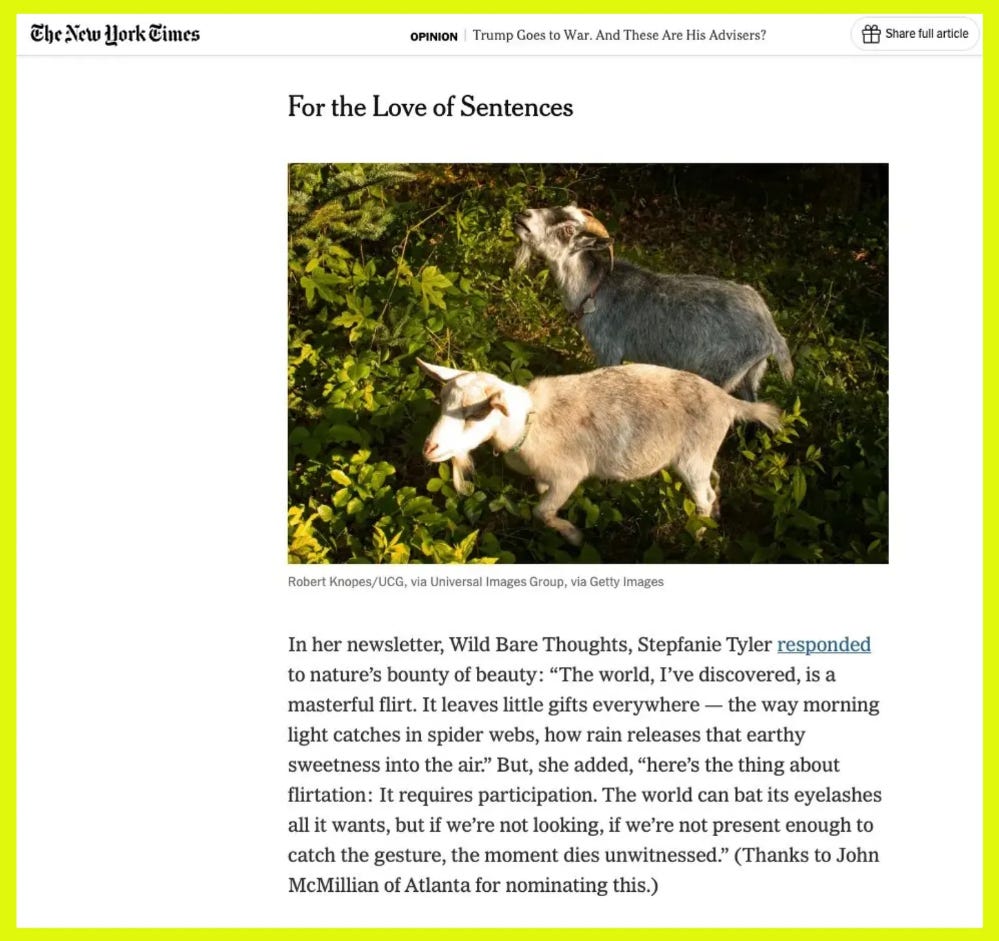


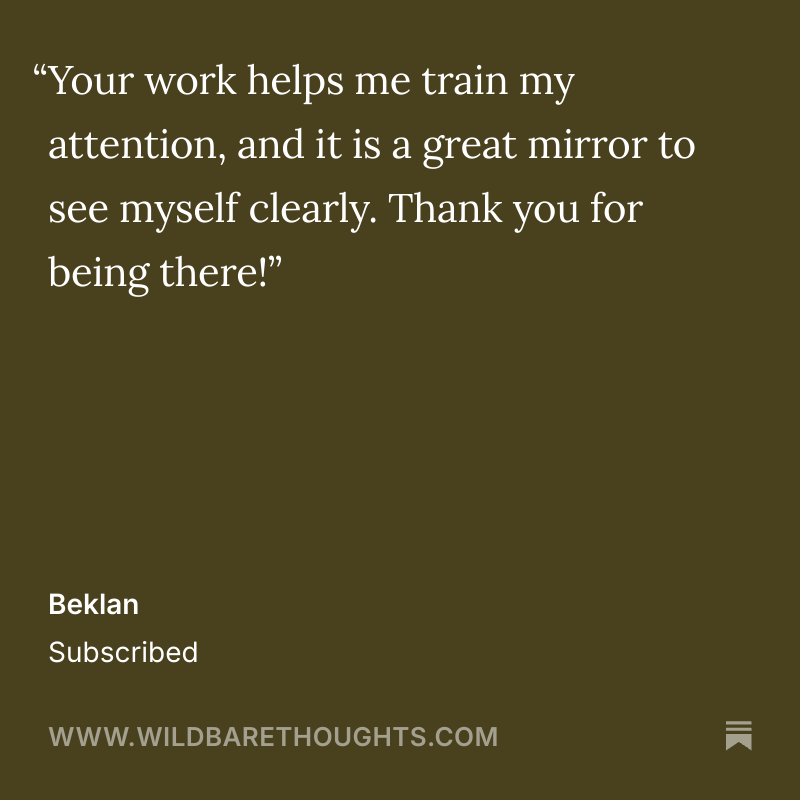


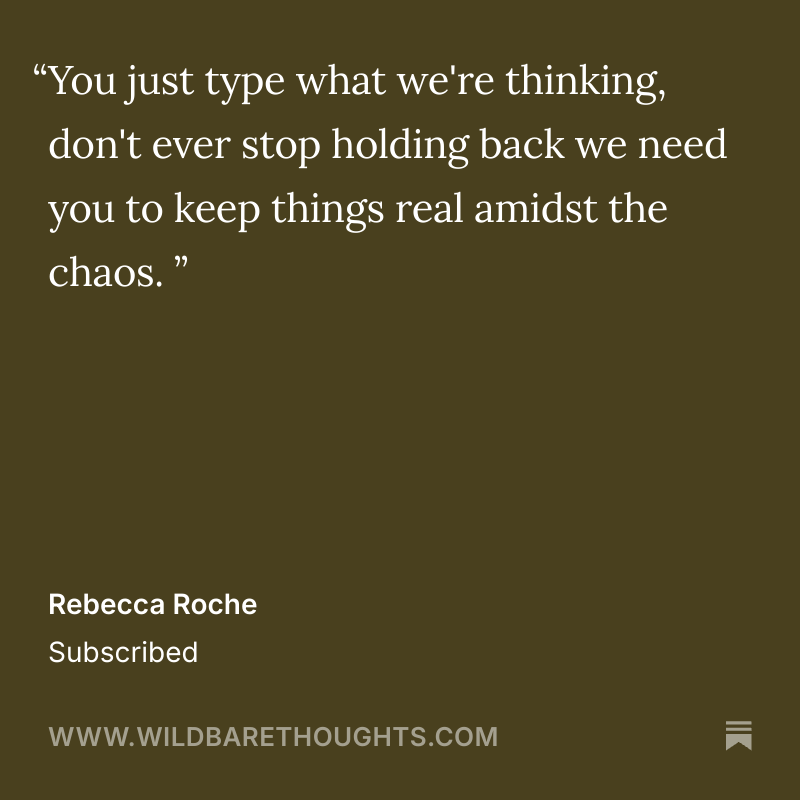



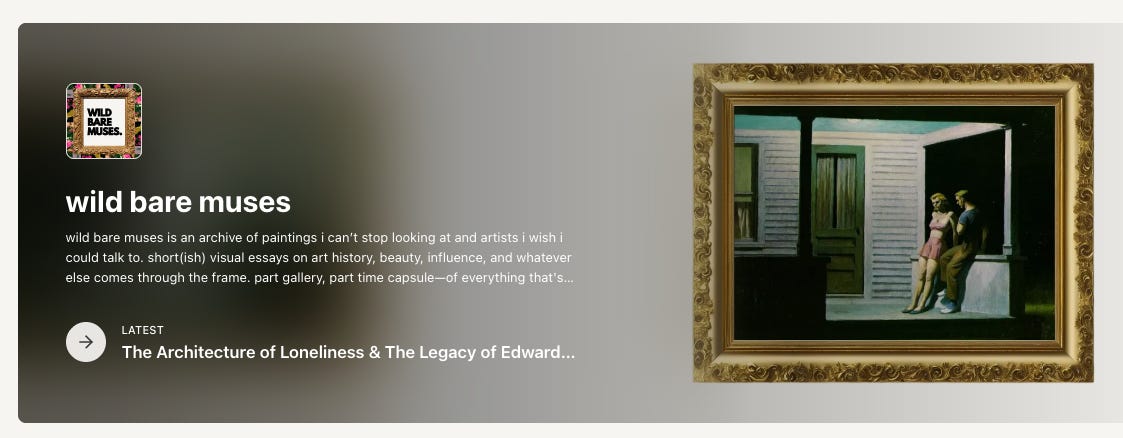
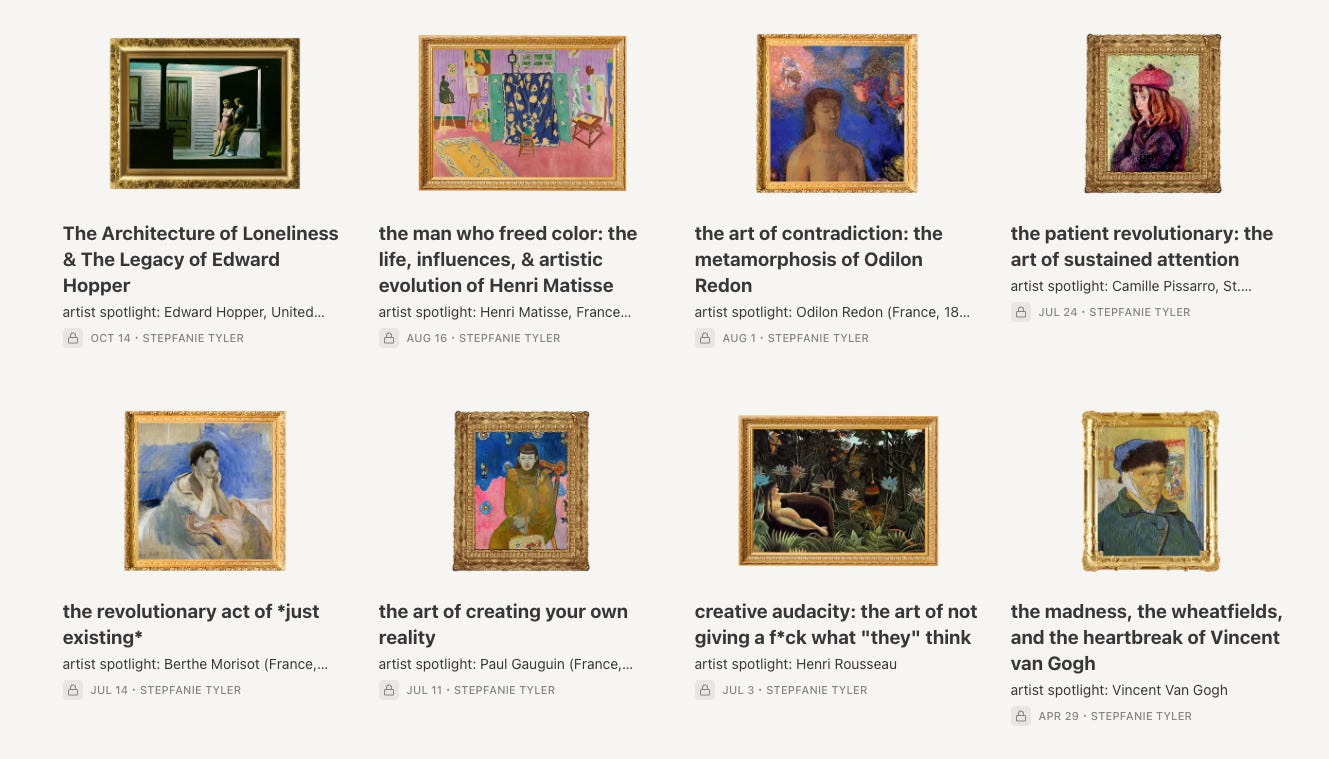
![[a wild bare guide] to self-sovereignty](https://substackcdn.com/image/fetch/$s_!i8jr!,w_1300,h_650,c_fill,f_auto,q_auto:good,fl_progressive:steep,g_auto/https%3A%2F%2Fsubstack-post-media.s3.amazonaws.com%2Fpublic%2Fimages%2Fcf4012c0-bc00-4b35-bc42-16e6d755657d_4200x1050.png)

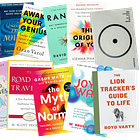

I really like your writing. Keep on writing. Ignore the haters, the enviers, and the naysayers.
Thanks for writing this, it clarifies a lot, as your journey clearly shows, how consistent, dedicated effort is truly the most crucial element for cultviating a genuine audience and achieving meaningful impact online.